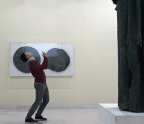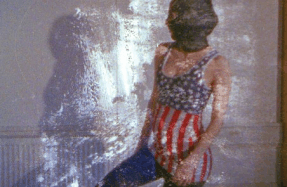
“The past is of no importance. The present is of no importance. It is with the future that we have to deal. For the past is what man should not have been; the present is what man ought not to be; the future is what artists are.”
—Oscar Wilde, “The Soul of Man Under Socialism”
David Cronenberg’s Crimes of the Future may be marked as a “return” for the 79-year-old director in a number of respects. His first feature in eight years, it is also his first to be based on an original script since eXistenZ. In addition, Crimes sees Cronenberg revisiting, after a fashion, his 1970 film of the same name, from which he’s taken the central premise of genetic mutations in humans which have resulted in the spontaneous growth of new organs. More significant than these surface continuities, however, is Crimes’ forceful renewal of a question that Cronenberg has arguably never abandoned, but which has only become more insistent in this, his late period—the question, that is, of what it means to produce the new. What does it mean to imagine—to image—the future? In the 1970 film, the organ-generation phenomenon is described as a kind of “creative cancer”; following French philosopher Henri Bergson’s major work, we might alternatively speak of a “creative evolution.” This opposition in mind, we may see Crimes as charting the transformations necessary for one judgment to give way to the other, and thereby marking the passage into that void we call the future.
Cronenberg’s chosen milieu to explore all this is the art world, or what passes for the art world in the decrepit, hollowed-out Athens where Crimes takes place. After a prologue in which a mother murders her young son, horrified by his ability to eat and digest a plastic wastebasket, Crimes mainly centres on Saul Tenser (Viggo Mortensen) and Caprice (Léa Seydoux), a pair of performance artists who have formed a symbiotic creative partnership. When first introduced, Tenser is rising from a sleepless night on his OrchidBed, a sarcophagus-like machine designed to adjust to his bodily needs, but which evidently needs some retuning. No matter, he has just produced a brand-new organ, never before seen, which also happens to be the raw material for the couple’s next piece. In their live performance, Caprice will, in a kind of literalist Grand Guignol style, remove the organ from Tenser’s prone body using a modified autopsy machine known as the SARK.
In the world of Crimes, Tenser’s ability to grow new organs is far from unique; indeed, it is but one manifestation of what has been called “Accelerated Evolution Syndrome,” which has also led humans to lose the sensation of pain. But no one else had the stroke of genius to have their auxiliary organs removed for the delectation of a rapt audience. And as the couple’s considerable fame suggests, there is no substitute for the act of seeing with one’s own eyes.
Like (1991) and , with which the new film shares aspects of its biomechanical visual design, presents us with an outwardly alien environment where our usual behavioural signposts are unmoored. Significantly, though, and very much unlike those films, gives us no reason to doubt its phenomenological coherence, so our interest mainly lies in making sense of its world as an organic whole and in placing Tenser (2012), Eric Packer’s desire to acquire the Rothko Chapel, which he proposes to move from Houston to his own apartment, asks us to consider a world where art has been completely stripped of its public function, reduced to nothing more than a unit of currency. imagines a world where performance art has become reigning paradigm of artistic production, revolving around talk of the artist’s presence, artistic “embodiment,” and slogans such as “Body is Reality.” (Take, for instance, experimental filmmaker Len Lye, who in the 1968 lecture-performance “The Absolute Truth of the Happiness Acid” asserted that his “absolute truth” was in “the gene pattern which contains the one and only natural truth of our being.”) In short, the film confronts us with a world where all art has become fundamentally theatrical.






